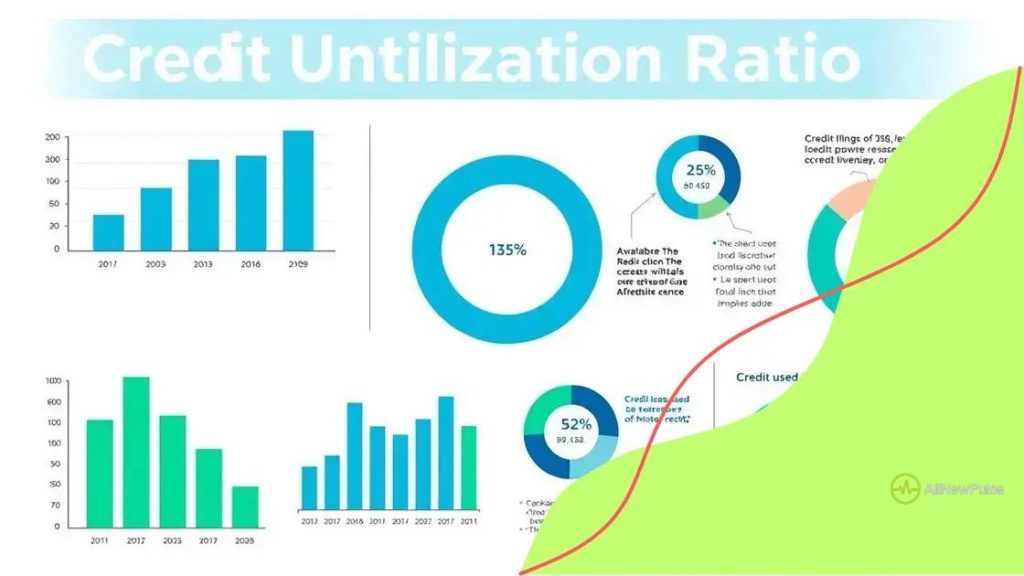Understanding credit utilization ratio: a key to better credit

The credit utilization ratio measures the percentage of your available credit that you are using, and maintaining it below 30% is crucial for maximizing your credit score.
Understanding credit utilization ratio is vital for anyone looking to manage their finances wisely. It’s not just about the numbers; it influences your credit score and overall financial health. Ever wondered how this ratio works or why it matters to you? Let’s dive in.
What is credit utilization ratio?
The credit utilization ratio is a key measure that lenders use to assess your creditworthiness. It represents the percentage of your available credit that you are currently using. Understanding this ratio can have a significant impact on your financial health.
Essentially, it tells lenders how well you manage the credit they have extended to you. A lower credit utilization ratio is generally seen as more favorable. But what exactly defines a good ratio?
What is considered a good credit utilization ratio?
Financial experts often suggest that maintaining a credit utilization ratio of below 30% is a good practice. This means you’re using less than 30% of your available credit limit.
- A ratio below 10% can help boost your credit score significantly.
- Between 10% to 30% can also be manageable, but not ideal.
- Above 30% might indicate to lenders that you are over-relying on your credit.
Maintaining a low credit utilization ratio is essential for improving and keeping a strong credit score. It’s simple: the less of your available credit you use, the better your credit health will appear to potential lenders.
There are several ways to manage your credit utilization ratio effectively. First, consider paying off balances more frequently. If you know you’re going to make a big purchase, pay down existing balances beforehand. Additionally, increasing your credit limit without increasing your spending can also lower your ratio, helping maintain a positive appearance to lenders.
Why does credit utilization ratio matter?
The credit utilization ratio matters because it contributes to about 30% of your credit score. This metric shows lenders how responsible you are with credit. If you keep your ratio low, it indicates to creditors that you are not overly dependent on credit, which is a positive sign. Conversely, a high ratio can raise red flags and can lead to a lower credit score.
Understanding the ins and outs of your credit utilization ratio can empower you to improve your financial situation. By managing it properly, you take significant steps toward securing better credit options and lower interest rates.
How credit utilization affects your credit score
Your credit utilization is a crucial factor that influences your credit score. It showcases how much of your available credit you are using at any given time. Understanding this connection can help you maintain or improve your score more effectively.
When you keep your credit utilization ratio low, you signal to lenders that you manage credit responsibly. A low ratio usually indicates that you do not rely heavily on borrowed funds, which can lead to a better credit score. This score is important, as it determines whether you can obtain loans and what interest rates you’ll pay.
What happens when your credit utilization is high?
If your credit utilization ratio is above 30%, it can negatively impact your credit score. Lenders may see this as a sign of financial distress. Here are some common consequences:
- Higher interest rates on loans.
- Increased difficulty in getting credit approvals.
- Lower overall credit score.
When your ratio remains high, lenders may perceive you as a greater risk, which can affect your borrowing options.
To keep your credit utilization in check, consider spreading your expenses across multiple credit accounts. This will not only keep your usage low on each account but also show a positive repayment history. Paying your balances in full before the due date can also help maintain a healthy ratio. Frequent monitoring of your credit utilization is essential as well. Checking your report allows you to adjust your spending and ensure you stay below the optimal limits.
Why credit utilization is more important than you think
The impact of credit utilization is more significant than many people realize. It accounts for about 30% of your FICO score. This means that managing this one factor well can lead to substantial improvements. It can help you qualify for better loans and interest rates, ultimately saving you money.
By recognizing the importance of your credit utilization ratio, you can make informed decisions about your financial life. Strategies to reduce your ratio, such as paying down debts and avoiding new debt when possible, lead to long-term financial success.
Tips to improve your credit utilization

Improving your credit utilization can significantly impact your credit score. It’s not just about borrowing less; it’s about managing your existing credit wisely. Here are some effective tips to help you enhance your ratio.
Increase your credit limit
A simple way to lower your credit utilization ratio is by increasing your credit limit. Contact your credit card issuer to request a limit increase. Just ensure you don’t increase your spending at the same time.
- Check your credit report to ensure you have a good standing.
- Request a limit increase strategically, ideally after demonstrating responsible credit use.
- A higher limit can help your utilization ratio drop without changing your spending habits.
Remember, it’s not just about the limit; it’s about how you handle the credit!
Pay off balances frequently
Another way to keep your credit utilization low is by paying your credit card balances more frequently than once a month. You don’t have to wait for the due date to make a payment. Consider making multiple payments throughout the month. This keeps your outstanding balance lower and may positively reflect on your credit report.
Use cash or debit
When possible, use cash or a debit card for purchases. This approach helps you avoid accumulating debt on credit cards and keeps your credit utilization ratio in check. Using cash prevents the cycle of overspending that can sometimes come with credit cards.
Monitor your credit report
Regularly check your credit report to stay aware of your credit utilization ratio. By keeping an eye on your financial standing, you can identify any issues early. Tools and apps are available that will alert you to any changes in your credit score, helping you manage your credit more effectively.
Good credit utilization is key to maintaining a healthy credit score. Improving your ratio not only helps your score but also gives you access to better loan terms and interest rates, saving you money in the long run. Implementing these strategies will help put you on the right track for better credit health.
Common misconceptions about credit utilization
Many people have misconceptions about credit utilization, which can lead to poor financial decisions. Understanding the truth about this important factor can help you manage your credit better. One common myth is that closing unused credit cards will improve your credit utilization.
In reality, closing a card reduces your available credit limit; this can increase your credit utilization ratio and potentially lower your credit score. It’s crucial to keep your old cards open, especially if they have no annual fees. Maintaining a long credit history is also beneficial for your credit health.
Myth: A low credit utilization ratio is always better
While keeping your credit utilization ratio below 30% is a good rule of thumb, a ratio of 0% can signal to lenders that you are not actively using credit. This could make you less appealing as a borrower. A small amount of credit usage shows lenders you can manage credit responsibly.
Myth: Credit utilization only matters for credit cards
Another misconception is that credit utilization only applies to credit cards. However, it is also important for lines of credit and personal loans. Any type of revolving credit impacts your utilization ratio. Understanding this can help you manage all your debts effectively.
- Be mindful of how much of your available credit you use across all accounts.
- Regularly check your utilization on various forms of credit.
- Manage both credit cards and lines of credit to maintain a healthy ratio.
Many consumers believe that paying the full balance each month is enough to ensure their credit utilization ratio remains low. While this is important, timing also matters. If you carry a large balance before your billing cycle ends, it might be reported and negatively affect your utilization ratio. You can prevent this by making multiple payments throughout the month, which keeps your balance low when the report is generated.
By debunking these common misconceptions, you can make better decisions regarding your credit utilization. Understanding how these factors work together will help you maintain a strong credit profile and improve your overall financial health.
Tracking your credit utilization effectively
Tracking your credit utilization effectively is crucial for maintaining a good credit score. Monitoring your ratio helps you make informed financial decisions, ensuring you stay within optimal limits.
One of the easiest ways to track your credit utilization is by using online tools or apps provided by financial institutions. Many banks now offer features that allow you to see your credit usage at a glance. This makes it simple to identify any spikes in usage that could negatively impact your credit score.
Set up alerts
Almost all credit card companies allow you to set spending alerts. By enabling these alerts, you can receive notifications when you are approaching your credit limit. This proactive measure helps you control your spending before it affects your credit utilization ratio.
- Set alerts for specific percentages (e.g., 30%, 50%).
- Receive notifications when a payment is due.
- Make adjustments to your budget based on alerts received.
Keeping an eye on your usage not only involves monitoring account balances but also understanding how often you plan to use your credit accounts. Consider checking your credit report at least once a year to see your overall credit utilization across all accounts.
Utilize financial tools
Using budgeting tools and apps can provide insights into your financial habits. These tools often categorize your spending, showing you where you can cut back, thus helping to keep your credit utilization low. You can set monthly spending limits, track expenses, and assess your payment history.
When tracking your credit utilization, remember to calculate the ratio effectively. To find your credit utilization ratio, divide your total credit card balances by your total credit limits. Multiply the result by 100 to get a percentage. Keeping this ratio under 30% is ideal for most lenders.
Additionally, consider requesting a credit line increase if you find it challenging to keep your ratio below the desired percentage. However, only do this if you can resist the urge to spend more. Tracking your credit utilization properly can optimize your score and maintain a healthy financial profile.
In conclusion, understanding and managing your credit utilization ratio is a crucial step in maintaining a healthy credit score. By staying informed about how this ratio works, using effective tracking methods, and making responsible financial choices, you can improve your credit health. Remember, keeping your utilization under control not only helps your credit score but also opens doors to better loan terms and interest rates. With the right strategies in place, you can enhance your financial future.
FAQ – Frequently Asked Questions about Credit Utilization
What is credit utilization?
Credit utilization is the percentage of your available credit that you’re currently using. It’s an important factor in calculating your credit score.
How does credit utilization affect my credit score?
A high credit utilization ratio can lower your credit score, while a lower ratio typically has a positive effect, demonstrating responsible credit management.
What is a good credit utilization ratio?
Generally, a credit utilization ratio below 30% is considered good. However, keeping it even lower, around 10%, is ideal for achieving a higher credit score.
How can I track my credit utilization?
You can track your credit utilization by using free credit monitoring tools, scheduling alerts for spending limits, and regularly checking your credit card statements.





